North Carolina Wildlife Species That Need Help Now
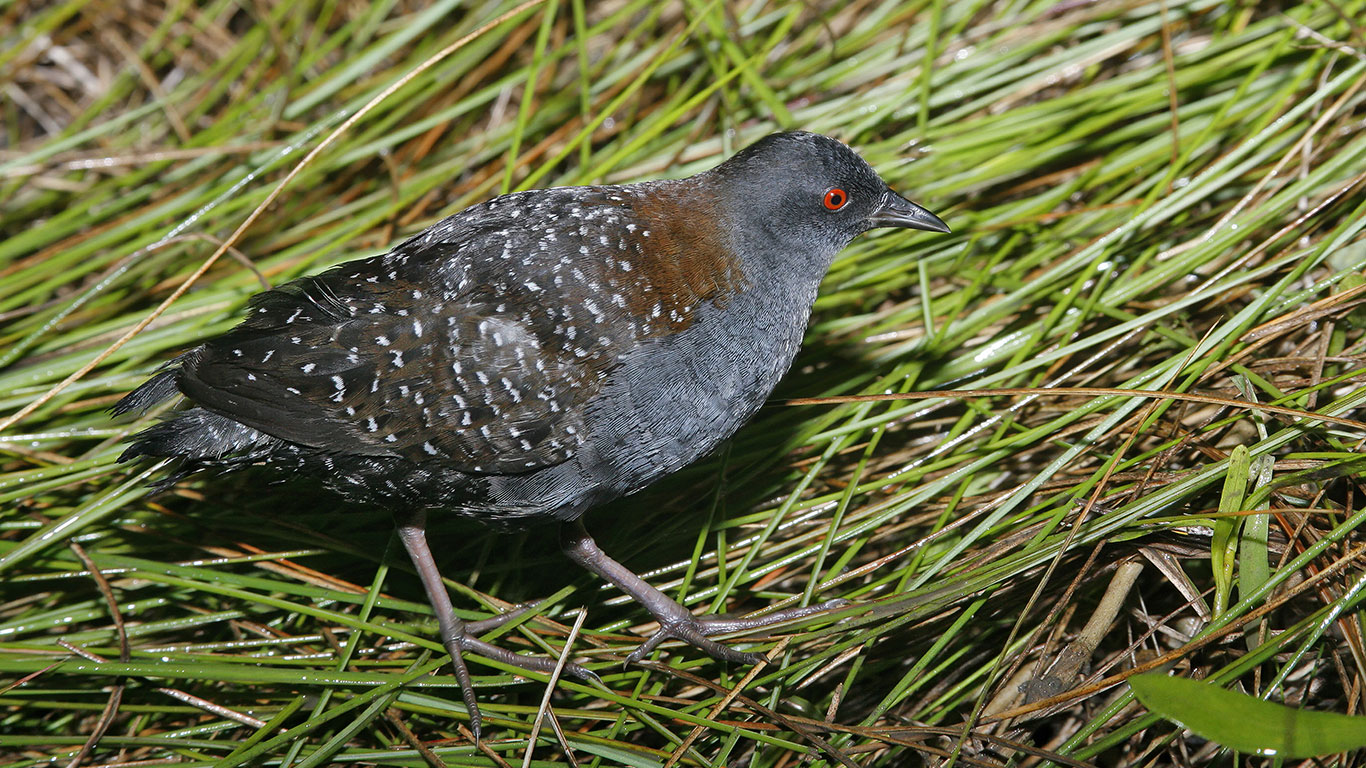
Many of North Carolina’s most beloved wildlife species are well known and pretty easy to spot. But many wildlife species are rarely seen, and are declining and of great conservation concern. There are 34 North Carolina wildlife species listed for protection under the Endangered Species Act, 109 listed as endangered or threatened in the state, and 129 listed as species of special concern in North Carolina. The state’s Wildlife Action Plan seeks to give these species the helping hand they need to thrive in the future. Here are six species of Tar Heel wildlife that you may have heard little about. But they are every bit as worthy of conservation action—and human awe—as sea turtles and elk. (Thanks to the science staff of the North Carolina Wildlife Resources Commission for these reports.)
The Little Piece of Stream Candy: Brook Floater
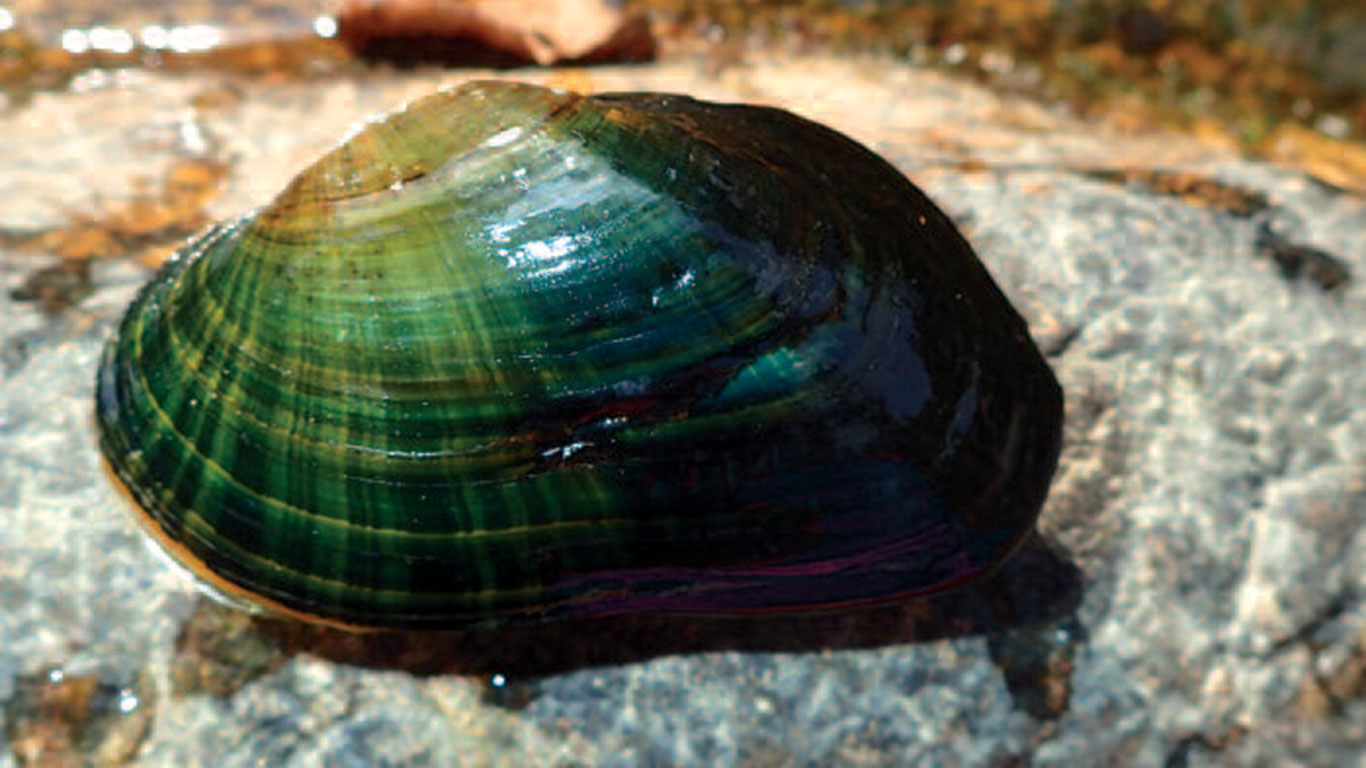 No, that’s not a Starburst fruit chew you see on the bottom of the river— it’s the foot of the brook floater mussel, a.k.a Alasmidonta varicosa. Although it’s called the brook “floater,” it actually lives at the bottom of rivers and streams, burrowing into the substrate with its bright orange foot. The second part of its Latin name, varicosa, refers to the varicose ridges along the side of its shell. Like all mussels, it is a filter-feeder, meaning it filters nutrients and minerals from the water in order to grow.
No, that’s not a Starburst fruit chew you see on the bottom of the river— it’s the foot of the brook floater mussel, a.k.a Alasmidonta varicosa. Although it’s called the brook “floater,” it actually lives at the bottom of rivers and streams, burrowing into the substrate with its bright orange foot. The second part of its Latin name, varicosa, refers to the varicose ridges along the side of its shell. Like all mussels, it is a filter-feeder, meaning it filters nutrients and minerals from the water in order to grow.
One of 60 mussel species in North Carolina, the brook floater is found in cool, clean streams along the Atlantic slope from Georgia to Canada. Unfortunately, this mussell is in decline over much of its range due to habitat loss and degradation. In North Carolina, it’s listed as State Endangered.
However, recent surveys in the Catawba, Yadkin-Pee Dee, and Cape Fear river basins have expanded the known range and population size of the brook floater in North Carolina. The Wildlife Resources Commission is also currently working on a captive breeding project to restore and enhance wild populations through- out its range in North Carolina. To accomplish this, NCWRC biologists must locate and collect pregnant (or “gravid”) mussels in the wild and then raise the young in captivity. Like most native mussels in North America, the brook floater is parasitic during its larval stage. The larvae attach on to a fish’s gills, get nutrients from the fish until they transform into juveniles, drop off, and begin life on the river bottom. (Don’t worry—the fish doesn’t even know the mussel is there!) Some mussels specifically parasitize only one or two fish species, but the brook floater is a generalist, meaning it is known to infest multiple fish species such as the margined madtom (Noturus insignis) and the longnose dace (Rhinicthys cataractae).
Because the brook floater has been in decline throughout other parts of its range in North America, the U.S. Fish and Wildlife “Service is deciding whether or not to grant the species increased protections nationwide under the Endangered Species Act. The WRC has contributed data on brook floater populations in North Carolina to help make a decision with the best, most up-to date- information possible in order to preserve the species for the future.”
—Anakela Popp and Michael Perkins
The Decidedly Peaceful Carolina Cobra: Southern Hognose Snake
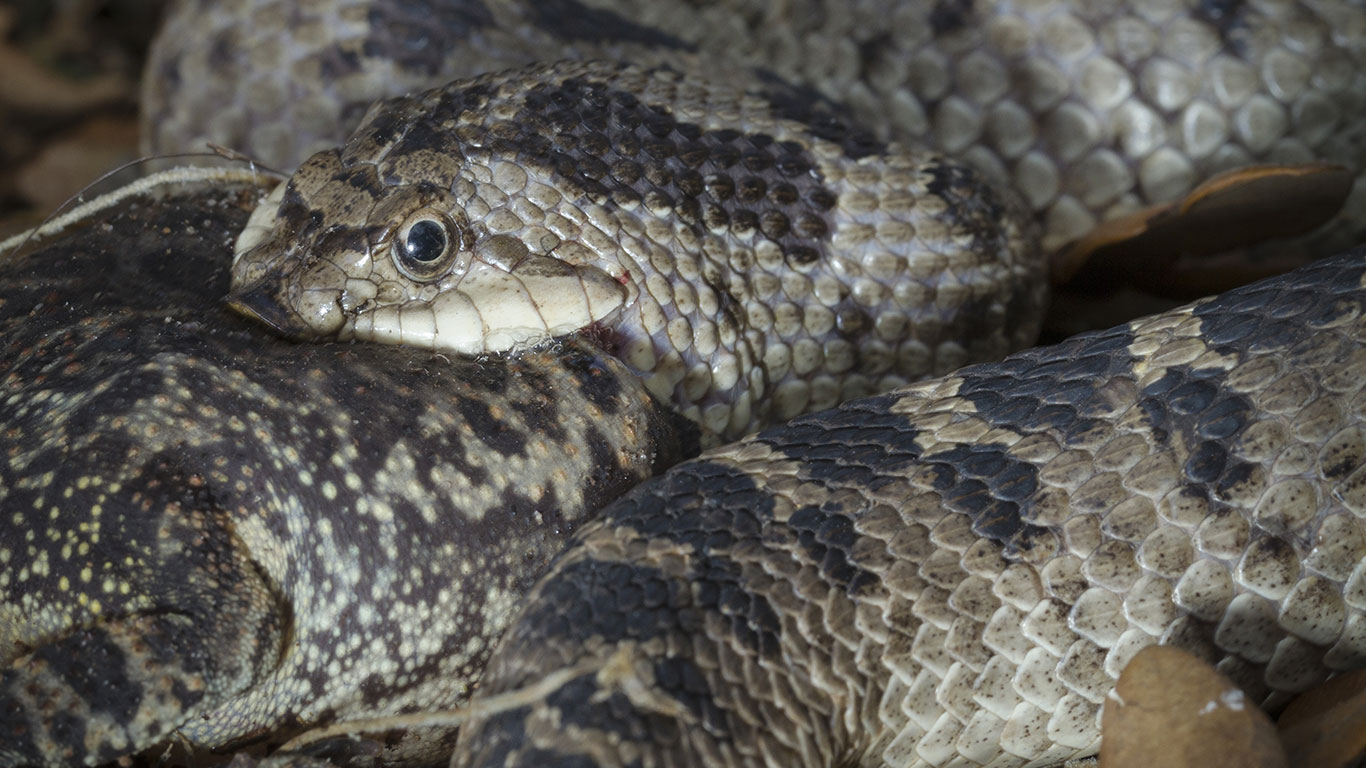 The southern hognose snake (Heterodon simus) is a small, stocky snake, rarely reaching a length of more than two feet. Characterized by a sharply upturned snout, used for digging burrows and finding prey, this feature is what gives rise to their common name. The uniform color of the belly distinguishes the southern hognose snake from the more common eastern hognose snake, which has a tail differently colored than the rest of the belly. The southern hognose ranges throughout the southeastern Coastal Plain, from North Carolina to southern Florida, and historically west to southern Mississippi and Alabama, though populations in the western part of their range appear to be extirpated. In North Carolina, this species is most abundant in the Sandhills, but populations occur in a few small spots along the southeastern Coastal Plain. Requiring very sandy soils, primarily within longleaf pine forests, the southern hognose spends most of its time either under- ground or within the leaf litter. Prey of adults consists primarily of toads and other amphibians, although juveniles also consume lizards.
The southern hognose snake (Heterodon simus) is a small, stocky snake, rarely reaching a length of more than two feet. Characterized by a sharply upturned snout, used for digging burrows and finding prey, this feature is what gives rise to their common name. The uniform color of the belly distinguishes the southern hognose snake from the more common eastern hognose snake, which has a tail differently colored than the rest of the belly. The southern hognose ranges throughout the southeastern Coastal Plain, from North Carolina to southern Florida, and historically west to southern Mississippi and Alabama, though populations in the western part of their range appear to be extirpated. In North Carolina, this species is most abundant in the Sandhills, but populations occur in a few small spots along the southeastern Coastal Plain. Requiring very sandy soils, primarily within longleaf pine forests, the southern hognose spends most of its time either under- ground or within the leaf litter. Prey of adults consists primarily of toads and other amphibians, although juveniles also consume lizards.
Hognose snakes are known for several strange and fascinating behaviors. When first threatened, hognose snakes flatten their necks, somewhat like the hood of a cobra, hiss loudly, and repeatedly false strike. They don’t open their mouths, but do go through the motions of a strike. If that behavior does not abate the threat, the next trick is to feign death, where the snake rolls onto its back, writhes around, and gapes its mouth with tongue extended. If picked up and turned over, a hognose snake will immediately roll back over, continuing the death feigning behavior until the perceived threat is gone.
Southern hognose snakes are declining throughout their range because of development, mortality from road traffic, and a loss of large tracts of well-managed Sandhills and Coastal Plain forests (mainly due to a lack of prescribed fire). Red imported fire ants appear to also pose a substantial problem for this snake, with ants possibly attacking and killing eggs and hatchlings. Though southern hognose snakes are very secretive and relatively difficult to detect, researchers have documented dramatic declines in the range of the species, leading them to be listed as a threatened species in North Carolina.
The WRC, along with the North Carolina Museum of Natural Sciences and other partners, conducts annual surveys for southern hognose snakes to document occurrences and to gather long-term data on population trends. These surveys usually involve slowly driving roads during the day in autumn, a peak movement activity period for the southern hognose. Radiotelemetry surveys are ongoing in the Sandhills by N.C. Museum of Natural Sciences biologists to document movements, home ranges, and the life history of these snakes. A mark-recapture study has also been continuing in the Sandhills for five years, hopefully to provide some idea of the number of these snakes still living in the region. Other direct conservation actions include increased prescribed burning on managed landscapes, wetland restoration which increases prey abundance (mainly southern toads and eastern spadefoot toads), and the purchase and conservation of lands to provide more habitat for the species.
—Jeff Hall and Jeff Humphries
The Vanishing Victim: Tricolored Bat
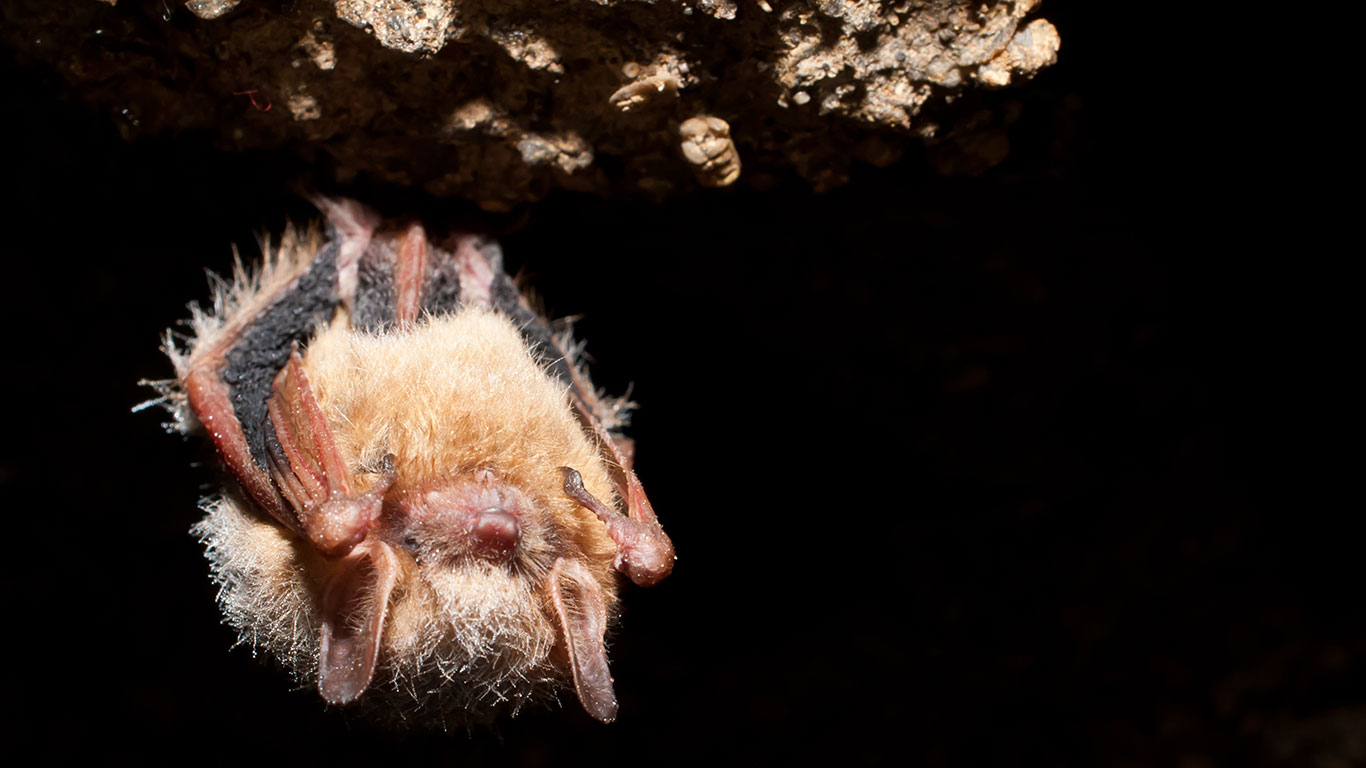 The tricolored bat (Perimyotis subflavus) is one of the smallest, if not the smallest, bat in North Carolina with a wingspan of nine inches, a weight of 0.3 ounces, and length of barely 3.5 inches. It was formerly known as the Eastern pipistrelle, but studies showed that it was not related to the Old-World genus. Its thin, uniquely colored hairs are dark grey at the base, yellowish in the center, and brown at the tip—hence the tricolor moniker. Documented in more than half of North Carolina counties, it very likely occurs in every county of the state. The species occurs throughout the Eastern U.S. from Canada to eastern Mexico. In spring, tricolored bats emerge from hibernacula, such as caves and mines, and disperse to summer foraging and roosting sites. Summer roosts are often in trees, rock outcrops, and infrequently, buildings. They forage along waterways and forest edges, and eat small flying insects.
The tricolored bat (Perimyotis subflavus) is one of the smallest, if not the smallest, bat in North Carolina with a wingspan of nine inches, a weight of 0.3 ounces, and length of barely 3.5 inches. It was formerly known as the Eastern pipistrelle, but studies showed that it was not related to the Old-World genus. Its thin, uniquely colored hairs are dark grey at the base, yellowish in the center, and brown at the tip—hence the tricolor moniker. Documented in more than half of North Carolina counties, it very likely occurs in every county of the state. The species occurs throughout the Eastern U.S. from Canada to eastern Mexico. In spring, tricolored bats emerge from hibernacula, such as caves and mines, and disperse to summer foraging and roosting sites. Summer roosts are often in trees, rock outcrops, and infrequently, buildings. They forage along waterways and forest edges, and eat small flying insects.
Before 2011, tricolored bats were one of the most common bats in North Carolina. Then the exotic fungal disease White Nose Syndrome (WNS) spread to the state. The tricolored bat is one of the most susceptible bat species to WNS.
The first step in any species conservation program is determining status and WRC does this through surveys and monitoring. There were hibernaculum and capture surveys in place before WNS spread to North Carolina, so there is a lot of data documenting declines. WRC reallocated staff to focus on bat surveys and WNS surveillance from 2009 to 2014. After WNS arrived in the state, the Commission implemented an acoustic monitoring program in the mountain region that uses ultrasonic detectors and volunteers to drive independent routes. This survey method to monitor bats, when added to the others, gives a clearer picture of trends for all bat species. WRC also incorporated WNS surveillance techniques and assisted researchers with gathering samples during our monitoring to further gain knowledge about the disease, its transmission and prevalence, and bat species-specific susceptibility. WRC expanded surveys to cover areas that had traditionally been concentrated in the southern mountains, but statewide coordination of bat surveys didn’t occur in earnest until a new staff member, Katherine Caldwell, was hired in 2015.
Unfortunately, hibernacula counts of tricolored bats are down 96 percent from pre-WNS counts. Mist-net surveys of tricolored bats are down 66 percent. These declines occurred in the first few years after arrival to each hibernaculum. Current trends indicate stabilizing populations but abundance remains low. WNS has not been documented east of Stanly County and does not seem to have affected susceptible bat populations in the Coastal Plain, either because it is not there or, more likely, because the disease cannot get a hold on bats that likely hibernate a lot less than western bats. We are open to assisting with research on potential treatments of WNS, which is currently being researched.
—Kendrick Weeks
The Ghost of the Salt March: Black Rail

This small and most secretive of the secretive marsh birds, the black rail (Laterallus jamaicensis) is named for its overall dark coloration and short black bill. It also has a distinctive brown coloration on the back of i
ts neck. Black rails are short distance migrants, and they breed in high marsh habitats in North Carolina. Nesting habitat is within high marsh and generally within less than 6 cm of standing water. Their distinctive kee-kee-der call is generally only heard at night or very early morning, during the nesting season. Black rails use both estuarine and inland fresh water marshes or early successional wetlands for breeding, wintering and migration habitat, although they seldom winter in North Carolina. Early records of black rails in the state were almost exclusively in fresh water marshes, but most observations of them in the past 40 years have been in coastal marshes. The reason for that habitat shift is not well known. It could be due to changes in agriculture practices in and around fresh water marshes, or perhaps black rails are still using inland marshes, but their secretive nature has produced few detections within these inland fresh water systems.
There has been much concern over the status of black rails in recent years. Breeding Bird Survey and e-bird surveys are not good indicators of population levels. John Fussell is a local birder from the coast of North Carolina and published author on North Carolina birds. He knows more about black rails in North Carolina than anyone. He says black rails have disappeared from most of their former range on the coast. Other mid-Atlantic states have seen similar declines. In fact, the population is estimated to be declining at about 9 percent annually. Over the past four years, WRC has contracted with the Center for Conservation Biology, from the College of William and Mary to conduct surveys. Even over these last four years, black rails seem to have declined. In 2014–15, 7.6 percent of 262 survey points detected black rails, but by 2017, only “1.4 percent of 284 points detected black rails. In fact, the only breeding locations within North Carolina that black rails can regularly be found are on Cedar Island National Wildlife Refuge, and the Piney Island military bombing range in Carteret County, as well as the Swanquarter National Wildlife Refuge in Hyde County.
WRC will continue to contract for survey efforts during the breeding season, with a focus on what can be done to reverse the decline in populations. In 2018, The Center for Conservation Biology will conduct surveys in inland marshes and early successional wetlands to determine if these birds are still nesting at inland locations. We hold some hope that inland waterfowl impoundments may suffice as breeding habitat, as these birds have been found in impoundments in the past. WRC manages over 2,000 acres of impoundments and has several game lands with potential estuarine black rail habitat.
—David Allen
High Country Crustacean: Grandfather Mountain Crayfish
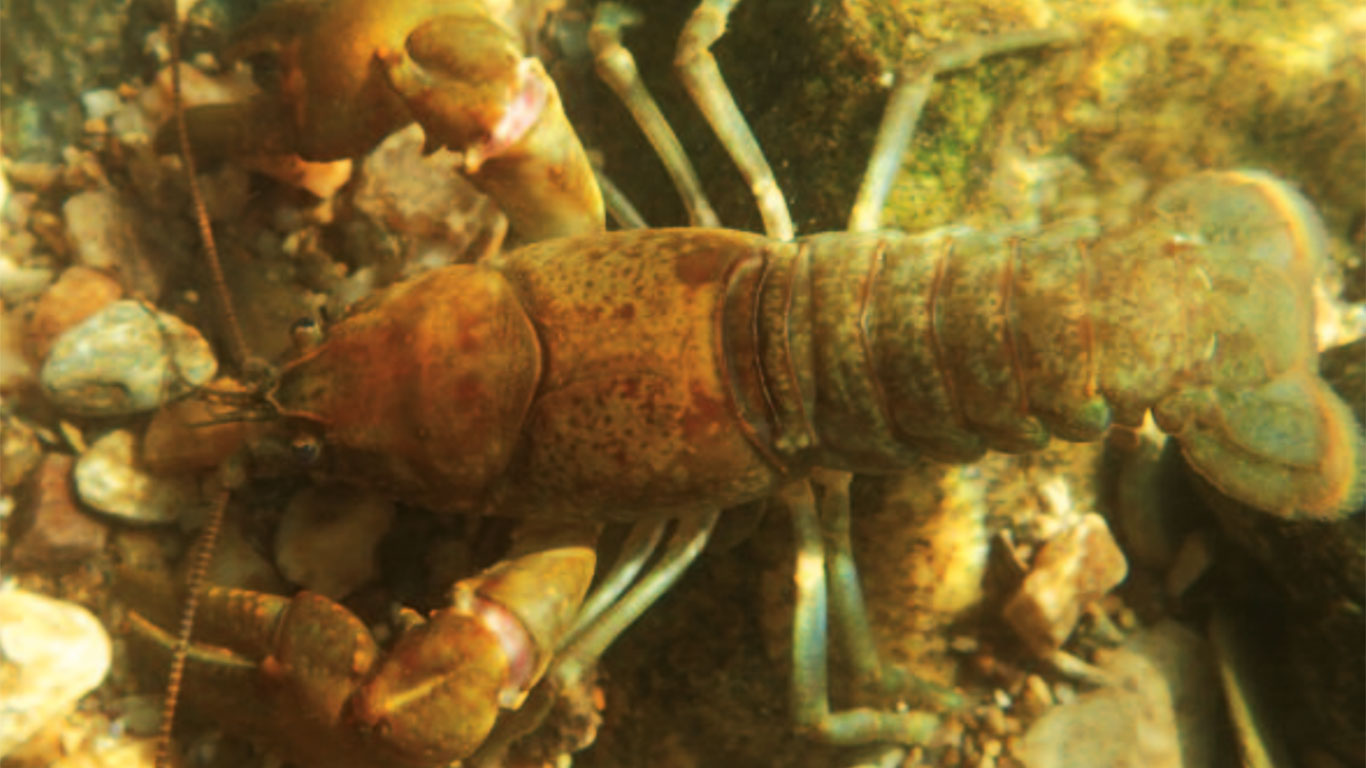 The Grandfather Mountain crayfish (Cambarus eeseeohensis) is a relative new- comer to the crayfish fauna of North Carolina. One of approximately 50 crayfish species that call the state home, it was named after the Cherokee word for the Linville River, Eeseeoh, which means “river of many cliffs.” Formally described as a species in 2005, the Grandfather Mountain crayfish was initially thought to be rare and found only in the Linville River upstream of Linville Falls in the mountains of Burke and Avery counties. Then surveys conducted by WRC and others in 2011 found the Grandfather Mountain crayfish in most streams throughout the Linville River and in the adjacent Watauga and upper Johns River watersheds.
The Grandfather Mountain crayfish (Cambarus eeseeohensis) is a relative new- comer to the crayfish fauna of North Carolina. One of approximately 50 crayfish species that call the state home, it was named after the Cherokee word for the Linville River, Eeseeoh, which means “river of many cliffs.” Formally described as a species in 2005, the Grandfather Mountain crayfish was initially thought to be rare and found only in the Linville River upstream of Linville Falls in the mountains of Burke and Avery counties. Then surveys conducted by WRC and others in 2011 found the Grandfather Mountain crayfish in most streams throughout the Linville River and in the adjacent Watauga and upper Johns River watersheds.
This species is the most abundant crayfish in the Linville Rivee and can be distinguished from other crayfish by its various orange, brown, and green camouflaged coloration, a variety of subtle characteristics on its claws or “chelae,” and by the distinct raised ridges along its nose or “rostrum.” While the Grandfather Mountain crayfish is endemic to the mountains of North Carolina, meaning the species can only be found here, it is not particularly rare and can be found in small creeks around Linville and Pineola, downstream deep in the Linville Gorge, and all the way to the shores of Lake James.
Typical water quality threats of mud and over fertilization (which create sedimentation and eutrophication) can degrade crayfish habitat but do not appear to be currently affecting populations of Grandfather Mountain crayfish. Agriculture and industrial development are rare in the region of the Blue Ridge Mountains where the crayfish is found. Over 60 percent of the species’ known range is managed through Pisgah National Forest, Grandfather Mountain State Park, the Blue Ridge Parkway, and The Nature Conservancy. These managed lands should protect most Grandfather Mountain crayfish populations for the foresee- able future. However, the greatest threat to this species and other native crayfish in North Carolina are introductions of exotic crayfish. Established populations of exotic crayfish such as the rusty crayfish and the red swamp crayfish are found in nearby watersheds and can out-compete native species for required resources. To protect unique native fauna like the Grandfather Mountain crayfish, we must strive to minimize introductions of non-native species. Because the region where this species and many other native and unique stream-dwelling animals are found is a popular coldwater fishery, it is important to remember to never release any live bait (such as crayfish) into any stream.
—T.R. Russ and Michael Perkins
Carolina Coral Reef Beauty: Waccamaw Killfish
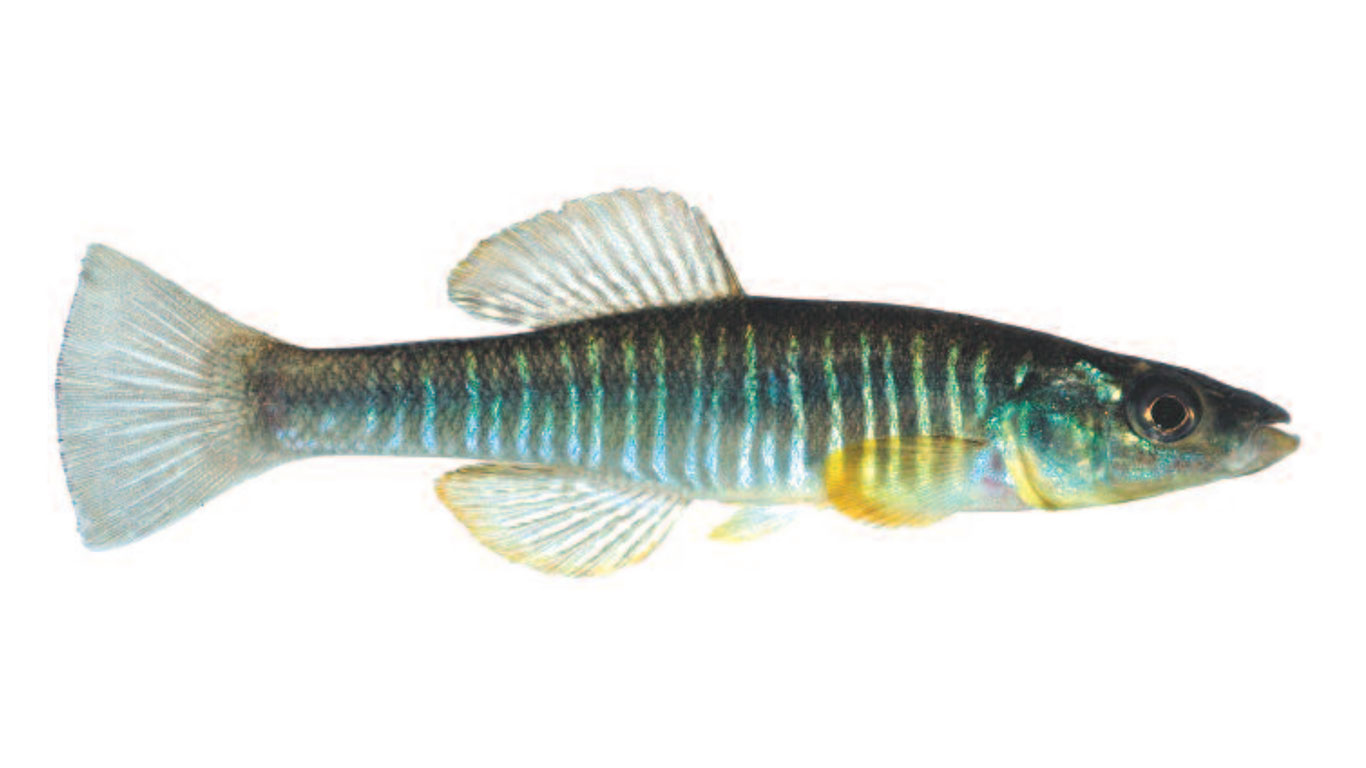 What if I told you about a brilliantly-colored fish, sides washed in turquoise and purple, contrasting bold vertical zebra stripes, cruising the water with fins tinged in gold and orange, unique in all the world to only a single location? You would probably ask me which coral reef it inhabited. But this beautiful animal is the Waccamaw killifish (Fundulus waccamensis), just one of several endemic species found in Lake Waccamaw, a 9,000-acre natural bay lake in Columbus County. Nestled in the heart of the Coastal Plain, the lake and its denizens are difficult to describe without resorting to clichés, for they truly are hidden gems of scenic beauty and biological diversity. You can visit both by way of Lake Waccamaw State Park, which includes the southeastern shoreline of the lake, with hiking trails as well as swimming and boating access.
What if I told you about a brilliantly-colored fish, sides washed in turquoise and purple, contrasting bold vertical zebra stripes, cruising the water with fins tinged in gold and orange, unique in all the world to only a single location? You would probably ask me which coral reef it inhabited. But this beautiful animal is the Waccamaw killifish (Fundulus waccamensis), just one of several endemic species found in Lake Waccamaw, a 9,000-acre natural bay lake in Columbus County. Nestled in the heart of the Coastal Plain, the lake and its denizens are difficult to describe without resorting to clichés, for they truly are hidden gems of scenic beauty and biological diversity. You can visit both by way of Lake Waccamaw State Park, which includes the southeastern shoreline of the lake, with hiking trails as well as swimming and boating access.
Waccamaw killifish are one of three endemic fishes residing in the lake and its immediate tributaries; the species is both a federal and state Species of Concern. Since 2009, WRC has conducted annual monitoring surveys in Lake Waccamaw to track the health and persistence of these rare species. The killifish, which mature to 3 to 5 inches long, school together in the shallow lake waters, hunting small invertebrates such as chironomid (non-biting midges) larvae. They also use adjacent canals and streams, including
the equally beautiful Waccamaw River, which originates at the southern end of the lake.
According to biological survey data, Waccamaw killifish populations appear to be persisting and successfully reproducing in the lake, where they lay their sticky eggs throughout the spring and summer. However, their habitat has been threatened by the introduction of hydrilla, an invasive exotic weed found covering over 600 acres in 2012, which grows underwater and, left unchecked, could choke out most of this clear, shallow lake. Hydrilla will not only make conditions uninhabitable for the killifish and co-occurring rare fish and mussel species, but will also prevent navigation by boats and other recreational uses due to entanglement.
WRC and North Carolina’s state parks, along with stakeholders such as N.C. State University, U.S. Fish & Wildlife Service, N.C. Division of Environmental Quality, and local citizens, have designed and implemented a management plan to attempt to eradicate the weed in an effort which enters its sixth year in 2018. While positive progress has been made, removal of hydrilla is extremely expensive and difficult, taking many years of treatment and with no guarantees of success. However, the most important and far more cost-effective step is prevention, which is up to each of us as citizens. Hydrilla and other aquatic invasive plants are most commonly transported on boats, trailers, live wells, and surfaces in contact with the water. It is critical that each time equipment is taken out of the water, before it goes anywhere else, it is thoroughly cleaned, drained, and dried to remove any hitchhikers in the form of plant fragments or other material which can lead to transport and introduction.
The striking Waccamaw killifish, its co-inhabitants, and their exquisite home in Lake Waccamaw are both unique and irreplaceable. With your help, generations to come will have the opportunity to enjoy these homegrown wonders just as we do. NC
—Brena Jones
